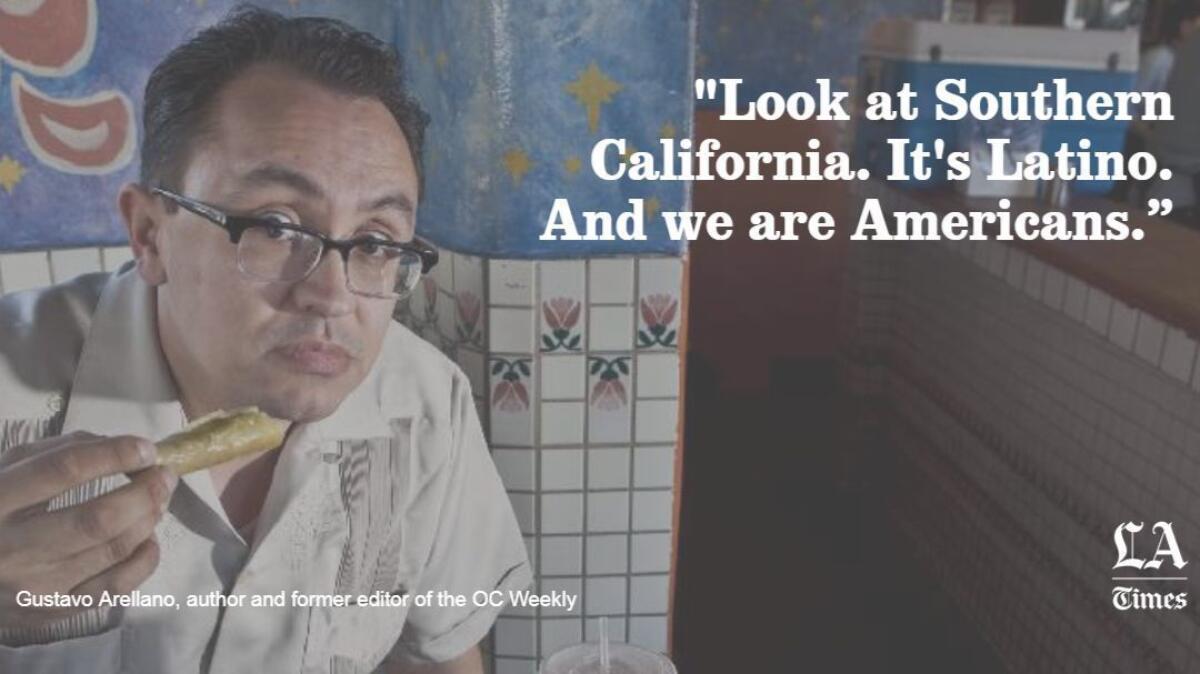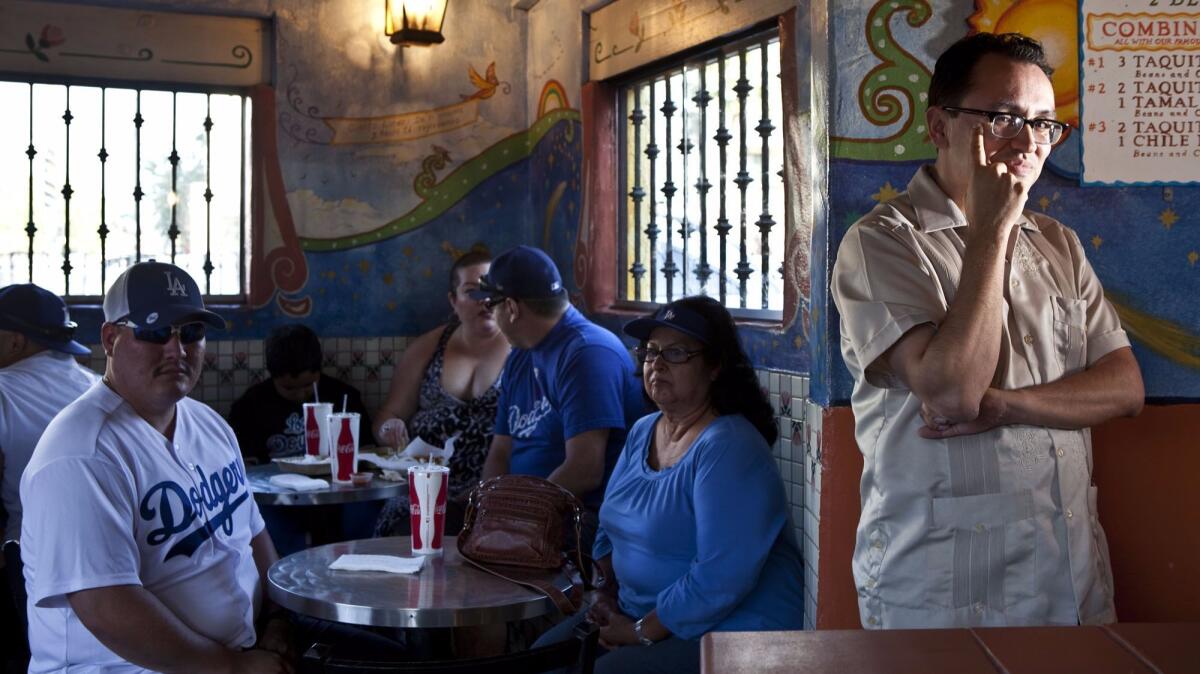Perspective: Why the departure of OC Weekly’s ‘Ask a Mexican’ columnist highlights the endangered status of Latinos in media

It began as a lark: a satirical advice column in which readers could write in and ask a question — any question — of the Mexican columnist. And the questions poured in. Why do Mexicans love dancing so much? Why do Mexicans call each other güey? Why do so many Mexicans whistle to communicate?
To these missives, most of which can’t be reprinted in their entirety due to salty language, Gustavo Arellano would duly respond in his “Ask a Mexican” column, published in the pages of the OC Weekly:
One reader wrote in to ask why cholos love Old English fonts then ended the missive by stating: “They’re ugly, just like everything about your culture.”
Arellano’s withering reply: “Dear Racist: The popularity of Old English script is a prison phenomenon that transcends race — just check out some of the tats on your white-supremacist cousins the next time they show up at your family picnic.”
I first stumbled onto “Ask a Mexican” about a decade ago, and it was a little bit like being hit by lightning. Here was a writer who was both mouthy and erudite. He took serious topics — like racism — and made them blisteringly funny. He deployed Spanglish slang without feeling like he had to explain it to death. And did it all while waxing poetic about things like the “mexcelente Mexi-mullet” of Los Tigres del Norte bassist Hernán Hernández.
For the OC Weekly, Arellano wrote about a host of other things too: music, food, culture and the sexual abuse scandals plaguing the Catholic Church in Orange County. He liked to muck around in historical archives. Since 2011, the weekly has run a semi-regular series about Orange County founders who were members of the Ku Klux Klan. And he wrote books, including the cultural history “Taco USA,” and served as a consultant on the now-defunct Fox animated series “Bordertown.”
Most significantly, as a writer, and later in his role as editor of the OC Weekly, he made the Latino experience — in particular, the Chicano experience — central to the media conversation, rather than the sidebar.

And he did it in a county that has been typically associated with the white and wealthy un-realities of “The Real Housewives of Orange County” and the early aughts TV drama “The O.C.” (Never mind that Orange County has been a majority-minority county since 2004 — and that the Mexican presence has been a mainstay since its foundation.)
“The fact that there was a Mexican running the OC Weekly?” Arellano tells me via telephone. “That was significant, because it shows we are here as the people who are helping move the conversation along. Look at Southern California, it’s Latino. And we are Americans.”
On Friday, after 15 years at the OC Weekly — almost six of them as its editor-in-chief — Arellano abruptly resigned from the paper. He declined to discuss the details of his resignation with The Times. But in an interview on the “Tom Leykis Show” on Friday afternoon, he stated that he had been asked to lay off half of his staff by the paper’s owners, Duncan McIntosh Co. Inc.
“I offered them a plan that would not involve losing all of those amazing, talented people,” he told Leykis. The plan, he said, involved cutting his own salary in half. The proposal was not accepted by the company and Arellano resigned.
In a statement issued to The Times last week, McIntosh, the OC Weekly’s president, said that the paper’s editorial staff and budget had “remained virtually unchanged for a decade” and that editorial expenses had “consistently exceeded” their limits. A status update posted to the weekly’s Facebook account noted Arellano’s service: “He will be missed, but his contribution to the newspaper and legacy of leadership will always be remembered.”

Whatever the details of Arellano’s resignation, his departure lays bare the shaky position that Latinos occupy in English-language media.
Arellano was the rare Latino editor-in-chief among American alt weeklies. In fact, he was the rare Latino leader at any English-language news organization — period.
According to census population estimates from 2016, Latinos account for almost 39% of the population of California and 18% of the total U.S. population, but remain conspicuously underrepresented in media both in the state and nationwide — especially at its top ranks.
On the television side, a report published by Columbia University’s Center for the Study of Ethnicity in 2014 revealed that only 1.8% of news producers at the top national news programs are Latino.
In newspapers, a 2016 newsroom diversity survey by the American Society for Newspaper Editors revealed that only 17% of newsroom workers are members of an underrepresented minority. The study didn’t break out individual minority groups, so it’s impossible to pinpoint Latino representation specifically. But given that Latinos and African Americans together comprise more than 30% of the U.S. population, it’s safe to say that newsrooms do not parallel the country’s demographic trends.
An analysis of high-ranking editors at major English-language dailies, released in August by the student reporting program at the Asian American Journalists’ Assn., reveal the same pattern. Latinos remain underrepresented — if represented at all. The New York Times and Washington Post each have one Latino editor on their mastheads. The Los Angeles Times has none (though the newsroom had the most diverse newsroom staff of the major newspapers polled.)
Arellano covered Latino culture as the mainstream it is, not as the exotic sidebar.
Certainly, the lack of a Latino presence affects not only the stories that get told, but how they get told — if at all.
The Columbia University study showed that from the nine-year period from 1995 to 2004, Latino-themed stories made up less than 1% of all network news stories — and those that did make it on air were largely about crime, terrorism or illegal immigration.
Of the three presidential debates held last year, for example, not one was moderated by a Latino — despite the fact that immigration was a burning issue throughout the election. (That wall? The prototypes are happening.)
At last month’s Emmy Awards, no Latino actor, director, producer or writer was nominated for any of the ceremony’s big awards. Writers such as Dennis Romero of LA Weekly and Patricia Garcia of Vogue highlighted the oversight — but the response was generally muted, with the story lasting barely one news cycle.
And when Beyoncé appeared on a remix of Colombian reggaeton star J. Balvin’s “Mi Gente,” it was suddenly being described by media outlets as “Beyoncé’s new song.” Except it wasn’t Beyoncé’s song. It was a collaboration between Balvin and DJ Willy William and it had already been on the charts for months. (Sorry, Beyhive.)
It is anecdotes such as this that made Arellano’s work and presence at the OC Weekly so important.
He ran stories about groundbreaking Latino chefs, stoner norteño bands, Latino Islamophobia and the Mexican legacy of Santa Ana — which he spelled “SanTana,” to mimic the Spanish pronunciation of the city’s name.
“People would say, ‘That’s not how it’s spelled!’” says Arellano. “But I say, that’s how the natives pronounced it.”
These stories were as central to the paper as were the reports about political corruption, police brutality, U.S. Rep. Dana Rohrabacher (R-Costa Mesa), sci-fi novelist Philip K. Dick and medicinal pot. In other words, Arellano covered Latino culture as the mainstream it is, not as the exotic sidebar.
The OC Weekly helps save Orange County from itself. It’s telling our history, about citrus wars, about Chicano murals, about the Black Panther Party...
“The OC Weekly helps save Orange County from itself,” he says. “It’s telling our history, about citrus wars, about Chicano murals, about the Black Panther Party, about desperadoes — all of those stories.”
Now that Arellano has left the OC Weekly, it leaves the Southern California media landscape just a little bit barren.
For years, publications outside of Orange County have courted Arellano. But he has steadfastly refused to leave — because he wanted to “stop the brain drain” of writers leaving the county, and partly because it was a place rich with stories — Latino and not — that simply weren’t getting told.
“It is a horrible place and it’s a beautiful place,” he says. “It’s paradise lost and paradise found.”
Now that he has left the OC Weekly, the publication with which he has been intimately identified with for so many years, the big question is what comes next.
Arellano will no longer write “Ask a Mexican,” since the OC Weekly owns the rights to the column. In the immediate future, he will focus on a number of freelance pieces he already had in the works — including a research trip to South Carolina. Among his various, non-OC Weekly pursuits, he has been a regular contributor to “Gravy,” the magazine of the Southern Foodways Alliance.
But the big picture? That’s still unclear.
“I’m going to wait for the tomato harvest,” Arellano says with a laugh, “and then I will think about things.”
Sign up for our weekly Essential Arts & Culture newsletter »[email protected]
ALSO
OC Weekly editor Gustavo Arellano resigns from alt-weekly newspaper in dispute over cost cuts
Celebrating the Chicana/o murals of L.A., some lost forever, with ‘¡Murales Rebeldes!’
Getting the ‘Bordertown’ cartoon right as border issues reemerge
With raw eggs and a roomful of clay, Anna Maria Maiolino makes unsentimental art about being a woman
More to Read
The biggest entertainment stories
Get our big stories about Hollywood, film, television, music, arts, culture and more right in your inbox as soon as they publish.
You may occasionally receive promotional content from the Los Angeles Times.










